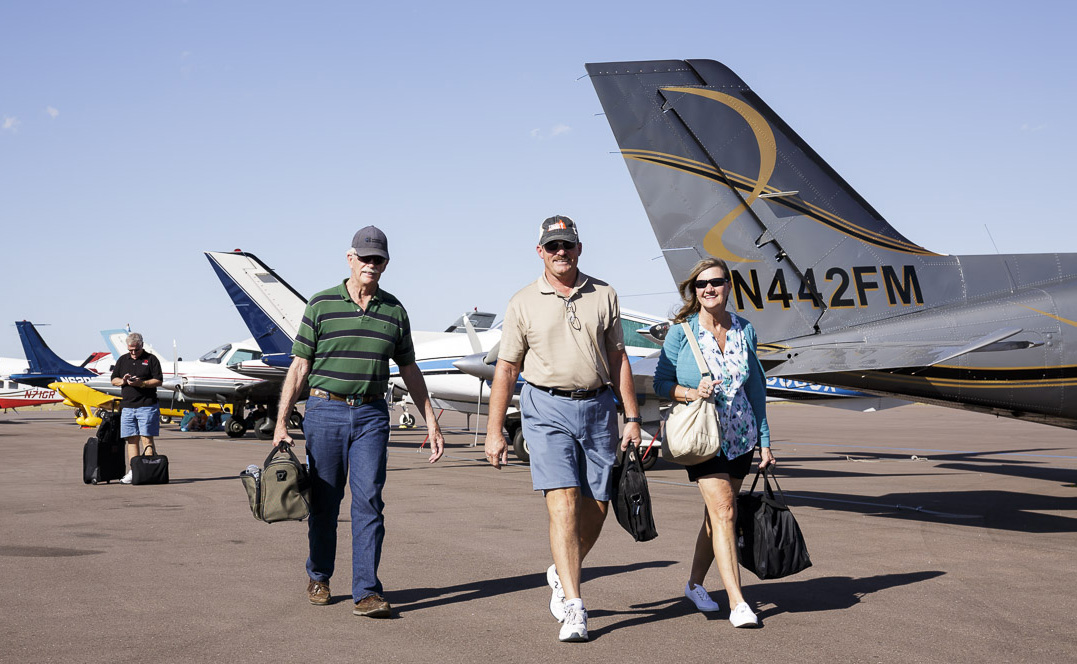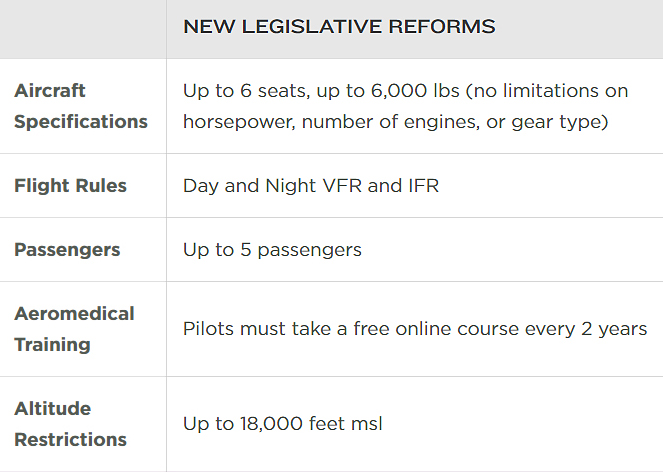Medical reform becomes law
President signs FAA extension

“We did it together! Medical reforms are now the law, and that’s a big win for general aviation,” said AOPA President Mark Baker. “It has taken years of commitment and hard work to make these reforms a reality. AOPA and EAA started the current reform effort back in 2012 when we petitioned the FAA for a medical exemption but the terms of that petition were much more limited than what pilots will get under the new reform law. This is something our entire community can get excited about.”
We did it together! Medical reforms are now the law, and that’s a big win for general aviation.—AOPA President Mark Baker
“The reforms are now law and that means we’re in the home stretch when it comes to getting more pilots flying without compelling them to repeatedly go through the expensive and burdensome medical certification process,” said Baker. “But there’s more work to do to ensure that the law is translated into regulations that make sense and work in the real world.”
Under the reforms, pilots who have held a valid medical certificate any time in the decade prior to July 15, 2016, may not need to take another FAA medical exam. The 10-year lookback period applies to both regular and special issuance medicals. Pilots whose most recent medical certificate was revoked, suspended, withdrawn, or denied will need to obtain a new medical certificate before they can operate under the reforms. Pilots who have never held an FAA medical certificate, including student pilots, will need to go through the process one time only.
After meeting the initial requirements to fly under the reforms, pilots will need to visit a state-licensed physician at least once every four years and take a free online course on aeromedical factors every two years. More details about these requirements and answers to the most common questions about the reforms are available on AOPA's FAQ page.
"We have fought long and hard for medical reforms and thanks to the support of GA supporters in both the House and Senate, those reforms are now the law. We are very pleased that pilots will soon reap the benefits, but the devil is always in the details, and some of those details will be worked out in the rulemaking process," said Jim Coon, AOPA senior vice president of government affairs. "That's why our team will be closely monitoring the FAA's next steps and providing input and the pilots' perspective at every opportunity."
The long road to medical reform
Medical reforms have been passed by the House and Senate, and signed into law. That’s a huge victory for general aviation pilots. But it’s a win that’s been years in the making.
As far back as 1979, AOPA petitioned the FAA to extend the validity of the third class medical certificate from two years to three. Then in the 1980s, AOPA petition the FAA to create the recreational pilot certificate. As first proposed, the recreational certificate would have allowed pilots to fly using only a driver’s license to fulfill the medical requirement, but that provision was removed from the final rule. In the early 1990s, AOPA again petitioned the FAA to extend the duration of third class medical certificate—this time to 48 months. And for a decade, AOPA worked with the FAA on developing regulations for light sport aircraft and the sport pilot certificate. Sport pilots have now been flying safely for more than a decade using only a driver’s license to meet the medical requirement.
Our most recent journey to medical reforms began in 2012 with another petition—this one filed by AOPA and the Experimental Aircraft Association. Follow along the winding path that began with that petition and has now made medical reforms a reality.
- March 20, 2012—AOPA and EAA file a petition with the FAA seeking a third class medical exemption to allow pilots to fly under day VFR conditions in fixed-gear, single-engine aircraft with up to four seats and up to a 180 horsepower engine. Under the requested exemption, pilots would be allowed to carry one passenger and fly no higher than 10,000 feet msl or 2,000 feet agl.
- September 14, 2012—Comment period closes on AOPA-EAA petition to create a medical exemption. The FAA receives more than 16,000 comments. The overwhelming majority support the proposed exemption.
- December 11, 2013—The General Aviation Pilot Protection Act (GAPPA), H.R. 3708, is introduced in the House after the aviation community becomes frustrated by the long wait for the FAA to respond to the AOPA-EAA petition. GAPPA expands on the terms of the AOPA-EAA medical petition and would allow pilots to carry up to five passengers in a six-seat aircraft weighing up to 6,000 pounds under VFR conditions.
- December 26, 2013—FAA Administrator Michael Huerta apologizes for the delay in taking action on the AOPA-EAA petition for a medical exemption and promises to move as quickly as possible. The apology comes in a letter responding to a formal request from AOPA for an update on the status of the petition.
- March 11, 2014—GAPPA legislation is introduced in the Senate as S. 2103.
- April 2, 2014—The FAA announces plans to go through a rulemaking process for medical reforms, which the agency calls the “Private Pilot Privileges without a Medical Certificate” project.
- April 8, 2014—The Government Accountability Office (GAO) releases a report that finds problems with the FAA medical certification process, including delays, technological issues, inappropriate standards, and lack of clarity.
- May 6, 2014—GAPPA reaches 100 co-sponsors in the House and 10 in the Senate.
- July 31, 2014—FAA Administrator Michael Huerta announces that a proposed rule to reform the third class medical certification process has been sent to the Department of Transportation (DOT) for review. The DOT has 90 days to review the rule.
- August 14, 2014—AOPA and six other GA groups send a letter urging DOT Secretary Anthony Foxx to quickly complete the agency’s review of the FAA’s proposed medical reform rule. Over the following weeks, similar letters are also sent to DOT and the Office of Management and Budget (OMB), which must also review the proposed rule, by Reps. Sam Graves (R-Mo.) and Todd Rokita (R-Ind.); Sen. Mark Begich (D-Alaska); 32 members of the House GA Caucus; the Flying Physicians Association; 11 senators who are GAPPA co-sponsors; the AOPA Medical Advisory Board; and the Type Club Coalition. Despite these efforts, the review process is never completed.
- November 14, 2014—Support continues to grow for GAPPA, which reaches 178 co-sponsors in the House and Senate.
- December 11, 2014—The 113th Congress comes to a close, and with it GAPPA expires.
- January 13, 2015—AOPA sends DOT a strongly worded letter urging the agency to end its seven-month delay in reviewing the FAA’s proposed medical reform rule.
- February 25, 2015—The Pilot’s Bill of Rights 2 (PBR2), which includes third class medical reforms, is introduced in both the House (H.R. 1062) and the Senate (S. 571). PBR2 would allow pilots to fly in day or night VFR or IFR conditions, carrying up to five passengers in an aircraft with up to six seats and weighing no more than 6,000 pounds.
- June 23, 2015—AOPA members contact their elected officials more than 78,000 times to urge their support for PBR2 and its medical reforms. The legislation has 143 co-sponsors in the House and Senate.
- July 16, 2015—A renewed call to action prompts nearly 70,000 AOPA members to contact their elected officials and urge them to support PBR2.
- July 22, 2015—GA supporters file an amendment to the Senate highway bill that would include third class medical reform in the legislation. The amendment does not make it into the final legislation but support for PBR2 continues to grow with 164 House and Senate co-sponsors.
- November 16, 2015—AOPA and 16 other groups send a letter to leaders of the Senate Committee on Commerce, Science, and Transportation, urging them to pass PBR2.
- December 9, 2015—The Commerce Committee sends PBR2 to the full Senate.
- December 15, 2015—The Senate passes PBR2, S.571, by unanimous consent
- February 3, 2016—The House introduces an FAA reauthorization bill (H.R. 4441) that includes third class medical reform.
- February 11, 2016—The House Transportation and Infrastructure Committee approves H.R. 4441.
- April 19, 2016—The Senate passes third class medical reform again, this time as part of its FAA reauthorization legislation, which passed on a strongly bipartisan 95-to-3 vote.
- June 8, 2016—AOPA issues a call to action and thousands of members contact their representatives in the House and urge them to take up S.571, also known as PBR2.
- June 14, 2016—The Senate passes third class medical reform language as part of the National Defense Authorization Act by a vote of 85 to 13.
- July 6, 2016—An FAA funding extension deal reached by House and Senate negotiators is announced. The extension deal includes third class medical reform language.
- July 11, 2016—By voice vote, the House passes third class medical reform as part of the FAA funding extension bill.
- July 13, 2016—The Senate passes third class medical reform as part of an FAA funding extension bill by a vote of 89 to 4, marking the fourth time in eight months that the Senate has passed medical reform language. Under the medical reforms passed by the House and Senate, pilots can obtain an exemption from FAA medical certification that allows them to fly an airplane weighing up to 6,000 pounds with up to six seats in day or night VFR or IFR conditions. They may carry up to five passengers traveling at altitudes below 18,000 feet msl at speeds of up to 250 knots. The legislation goes to the president for his signature ahead of a July 15 deadline.
- July 15, 2016—We did it! Medical reforms are signed into law by President Barack Obama, paving the way for the FAA to begin a rulemaking process that could take up to one year.





